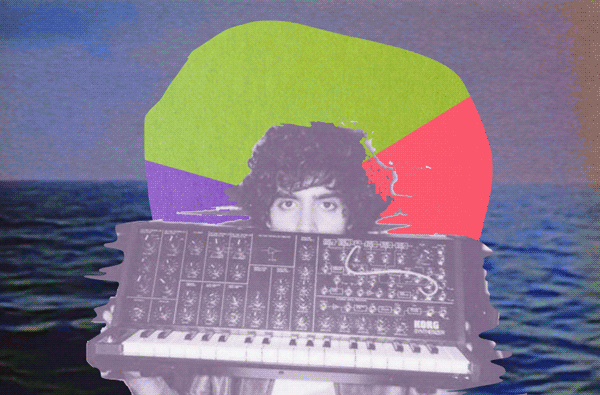Ten years ago, Alan Palomo was living in Austin, Texas – somewhat isolated from the world. He obsessively worked on dance music for his band VEGA, but after plans to drop acid with a friend fell through, Palomo began tinkering with what eventually would become Neon Indian.
Famously, the song “Should Have Done Acid With You” was an apology to his friend, visual artist Alicia Scardetta for missing their drug date. After he sent it, Scardetta gave him feedback that changed his outlook on the music he was creating.
“I remember that the first song ‘Should Have Taken Acid With You’ was sort of a spontaneous experiment. I had accumulated a bag of tricks through Vega and Ghosthustler that I wasn’t able to implement in those projects, and it came from the other side of what I wanted to do more [of], rooted in lo-fi music and things like Italo disco,” he tells Remezcla. ”I realized that before it was called Neon Indian, it was basically finally finding the intersection point of what I loved about dance music and what I loved about lo-fi experimental music.”
Palomo had come to find that working on dance music could be incredibly tedious. While working on VEGA’s EP Well Known Pleasures, he realized he was more interested in dance music as a medium, but the production became taxing. Working on a lo-fi project allowed him to be more creative with other aspects of production. “I often found that I spent more time tweaking a kick drum and trying to get it to sound perfect that by the time I got around to that, I would forget why I started writing the song in the first place,” he shares.


While starting to work on what eventually became Neon Indian’s debut album, Psychic Chasms, Palomo recalls changing his entire creative process. “I figured out a new workflow I had never tapped into before. I sat down and I wrote that song, and then seven hours later the song was done. I remember it was like 3 in the morning, and my friends and I went to Whataburger. It birthed a new creative exercise. You’re going to wake up that day and start working on a song and then when it gets to be night, that’s the song that you have; that’s what you’re stuck with.” After figuring out this new process, Palomo says the album was done in about a month or so before it was sent out.
Working on a new project couldn’t have come at a better time. In his own words, Palomo felt isolated. He had recently moved to Austin after his previous project, Ghosthustler, ended in Denton, Texas. He was trying to get back into film school, his first passion, but was hindered by circumstances like not having a car and a permeating feeling that perhaps he wasn’t right for academia. “I had a job I didn’t like, school was in jeopardy, and music was sort of a growing pain – production wise. Neon Indian changed how I looked at music.”
The situation he found himself in made him decide to take a semester off to concentrate on music, much to the chagrin of his parents. However, moving forward on Neon Indian, he was able to capture the feelings of frustration and angst he was dealing with. “There’s so much biographical stuff in Psychic Chasms. My newer albums are more like a screenplay. Some of the most pure unadulterated sincerity exists in Psychic Chasms,” he says.

Musically, Palomo credits a variety of artists for Neon Indian’s sound. He was obsessed with Yellow Magic Orchestra and Todd Rundgren at the time. So much so, that Rundgren’s “Izzat Love” was the main sample on “Deadbeat Summer.” He also credits songs like Righeria’s “Vamos a la Playa,” and tracks by his father Jorge Palomo, who had a pop career in Mexico in the late ‘70s and early ‘80s.
His love of film also makes its way into his music. “I was watching a lot of downer films. I remember the three that really resonated [with me] at the time, and kind of invoked the titles like ‘Deadbeat Summer’ or ‘Terminally Chill,’ were My Own Private Idaho, Stroszek, and Vagabond. All these movies about lovable f*ck-ups that seem to always be orbiting around some goal, but some internal mechanism always keeps them away from it. I really related to that.”
While finishing up the record, Palomo anonymously released some songs to DFW blog Gorilla vs Bear, and the buzz came quickly. He originally chose to release tracks anonymously to avoid any comparisons to his other projects or to the hype of Ghosthustler; he wanted to give it its own legs. Ultimately, he debuted “Deadbeat Summer” on Pitchfork in late July of 2009. Unbeknownst to him, he wasn’t the only one experimenting with lo-fi sounds. That year, bands like Toro y Moi, Washed Out, and Small Black released dreamy and wistful tracks that seemed to capture some type of electronic nostalgia.

The sound was like yacht-rock for a post recession generation that didn’t aspire to own a yacht. Like if Michael McDonald grew up playing Nintendo. The sound was an emotional crash after the highs of the bloghaus and electro era. Dubbed “chillwave” by the writer Carles for the satirical blog Hipster Runoff, the term came to define the musicians for better or worse. Chillwave seemed dismissive to the musicians that defined the genre, and even garnished some backlash and a scathing New York Times write-up at the time.
Neon Indian and the bands who helped shape the moniker have all grown beyond the original trappings that defined the style, and they continue to release music. With 10 years in the rearview, Palomo sounds as though he’s softened up to the term “with a bit of nostalgia; ironic, since chillwave was branded as nostalgia.”
He recalls being excited to be interviewed by XLR8R in February of 2010, when the band was breaking out. When he finally read the article, he realized it was a think piece about chillwave, instead of a celebration of his work. “It definitely felt like a bit of a slight. It wasn’t about the music per se; it was about the ecosystem that created the music. In a weird way, it was kind of a blueprint for how the internet creates genres now. It was a very new thing,” Palomo says.

Despite the slight, he can look back at the popularity and the future generations of music it may have inspired. “It has formed a whole other generation of musicians who are making stuff now. I’m very proud of that lineage. Time has proven that now, everyone loves putting lo-fi sounds or warbled guitars in their shit – that’s the sound now. It’s become kind of ubiquitous. It’s been kind of funny to watch the narrative of lo-fi music kind of play out in this last decade, and that’s the thing I feel pretty good about.”
Chillwave’s influence is undeniable. It can be heard in the music of young latinx artists like Cuco, Los Retros, or Omar Apollo. There was an immediate impact as well: In 2010, Childish Gambino used “Deadbeat Summer” as a backing track. Drake thanked Neon Indian and other chillwave artists in the liner notes to his debut album Thank Me Later.
He now has a 10-year career in music to look back on. He set out to create music, and within months was playing festivals and appearing on late night TV shows. Neon Indian is currently working on their fourth album and hitting the road this fall. Although Palomo generally feels his later work is his most well-rounded and truly represents his growth as an artist, he is proud of all he has produced and what it means to his greater story. “It’s ironic that sometimes the things you put the least amount of thought into can sometimes come to define you the most.”





